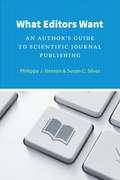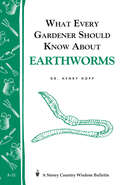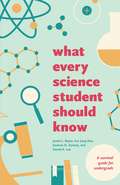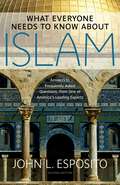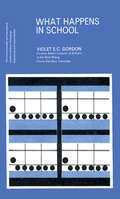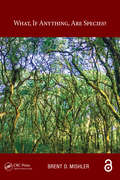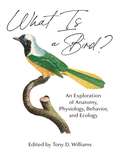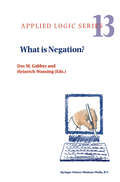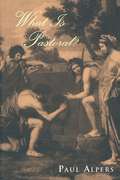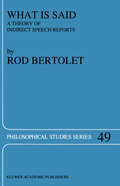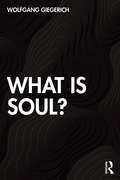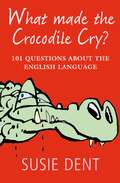- Table View
- List View
What Editors Want: An Author's Guide to Scientific Journal Publishing (Chicago Guides to Writing, Editing, and Publishing)
by Philippa J. Benson Susan C. SilverResearch publications have always been key to building a successful career in science, yet little if any formal guidance is offered to young scientists on how to get research papers peer reviewed, accepted, and published by leading scientific journals. With What Editors Want, Philippa J. Benson and Susan C. Silver, two well-respected editors from the science publishing community, remedy that situation with a clear, straightforward guide that will be of use to all scientists. Benson and Silver instruct readers on how to identify the journals that are most likely to publish a given paper, how to write an effective cover letter, how to avoid common pitfalls of the submission process, and how to effectively navigate the all-important peer review process, including dealing with revisions and rejection. With supplemental advice from more than a dozen experts, this book will equip scientists with the knowledge they need to usher their papers through publication.
What Editors Want: An Author's Guide to Scientific Journal Publishing (Chicago Guides to Writing, Editing, and Publishing)
by Philippa J. Benson Susan C. SilverResearch publications have always been key to building a successful career in science, yet little if any formal guidance is offered to young scientists on how to get research papers peer reviewed, accepted, and published by leading scientific journals. With What Editors Want, Philippa J. Benson and Susan C. Silver, two well-respected editors from the science publishing community, remedy that situation with a clear, straightforward guide that will be of use to all scientists. Benson and Silver instruct readers on how to identify the journals that are most likely to publish a given paper, how to write an effective cover letter, how to avoid common pitfalls of the submission process, and how to effectively navigate the all-important peer review process, including dealing with revisions and rejection. With supplemental advice from more than a dozen experts, this book will equip scientists with the knowledge they need to usher their papers through publication.
What Editors Want: An Author's Guide to Scientific Journal Publishing (Chicago Guides to Writing, Editing, and Publishing)
by Philippa J. Benson Susan C. SilverResearch publications have always been key to building a successful career in science, yet little if any formal guidance is offered to young scientists on how to get research papers peer reviewed, accepted, and published by leading scientific journals. With What Editors Want, Philippa J. Benson and Susan C. Silver, two well-respected editors from the science publishing community, remedy that situation with a clear, straightforward guide that will be of use to all scientists. Benson and Silver instruct readers on how to identify the journals that are most likely to publish a given paper, how to write an effective cover letter, how to avoid common pitfalls of the submission process, and how to effectively navigate the all-important peer review process, including dealing with revisions and rejection. With supplemental advice from more than a dozen experts, this book will equip scientists with the knowledge they need to usher their papers through publication.
What Editors Want: An Author's Guide to Scientific Journal Publishing (Chicago Guides to Writing, Editing, and Publishing)
by Philippa J. Benson Susan C. SilverResearch publications have always been key to building a successful career in science, yet little if any formal guidance is offered to young scientists on how to get research papers peer reviewed, accepted, and published by leading scientific journals. With What Editors Want, Philippa J. Benson and Susan C. Silver, two well-respected editors from the science publishing community, remedy that situation with a clear, straightforward guide that will be of use to all scientists. Benson and Silver instruct readers on how to identify the journals that are most likely to publish a given paper, how to write an effective cover letter, how to avoid common pitfalls of the submission process, and how to effectively navigate the all-important peer review process, including dealing with revisions and rejection. With supplemental advice from more than a dozen experts, this book will equip scientists with the knowledge they need to usher their papers through publication.
What Editors Want: An Author's Guide to Scientific Journal Publishing (Chicago Guides to Writing, Editing, and Publishing)
by Philippa J. Benson Susan C. SilverResearch publications have always been key to building a successful career in science, yet little if any formal guidance is offered to young scientists on how to get research papers peer reviewed, accepted, and published by leading scientific journals. With What Editors Want, Philippa J. Benson and Susan C. Silver, two well-respected editors from the science publishing community, remedy that situation with a clear, straightforward guide that will be of use to all scientists. Benson and Silver instruct readers on how to identify the journals that are most likely to publish a given paper, how to write an effective cover letter, how to avoid common pitfalls of the submission process, and how to effectively navigate the all-important peer review process, including dealing with revisions and rejection. With supplemental advice from more than a dozen experts, this book will equip scientists with the knowledge they need to usher their papers through publication.
What Every Gardener Should Know About Earthworms: Storey's Country Wisdom Bulletin A-21 (Storey Country Wisdom Bulletin)
by Henry HoppSince 1973, Storey's Country Wisdom Bulletins have offered practical, hands-on instructions designed to help readers master dozens of country living skills quickly and easily. There are now more than 170 titles in this series, and their remarkable popularity reflects the common desire of country and city dwellers alike to cultivate personal independence in everyday life.
What Every Science Student Should Know (Chicago Guides to Academic Life)
by Justin L. Bauer Yoo Jung Kim Andrew H. Zureick Daniel K. Lee“I am often amazed at how much more capability and enthusiasm for science there is among elementary school youngsters than among college students. . . . We must understand and circumvent this dangerous discouragement. No one can predict where the future leaders of science will come from.”—Carl Sagan In 2012, the White House put out a call to increase the number of STEM graduates by one million. Since then, hundreds of thousands of science students have started down the path toward a STEM career. Yet, of these budding scientists, more than half of all college students planning to study science or medicine leave the field during their academic careers. What Every Science Student Should Know is the perfect personal mentor for any aspiring scientist. Like an experienced lab partner or frank advisor, the book points out the pitfalls while providing encouragement. Chapters cover the entire college experience, including choosing a major, mastering study skills, doing scientific research, finding a job, and, most important, how to foster and keep a love of science. This guide is a distillation of the authors’ own experiences as recent science graduates, bolstered by years of research and interviews with successful scientists and other science students. The authorial team includes former editors-in-chief of the prestigious Dartmouth Undergraduate Journal of Science. All have weathered the ups and downs of undergrad life—and all are still pursuing STEM careers. Forthright and empowering, What Every Science Student Should Know is brimming with insider advice on how to excel as both a student and a scientist.
What Every Science Student Should Know (Chicago Guides to Academic Life)
by Justin L. Bauer Yoo Jung Kim Andrew H. Zureick Daniel K. Lee“I am often amazed at how much more capability and enthusiasm for science there is among elementary school youngsters than among college students. . . . We must understand and circumvent this dangerous discouragement. No one can predict where the future leaders of science will come from.”—Carl Sagan In 2012, the White House put out a call to increase the number of STEM graduates by one million. Since then, hundreds of thousands of science students have started down the path toward a STEM career. Yet, of these budding scientists, more than half of all college students planning to study science or medicine leave the field during their academic careers. What Every Science Student Should Know is the perfect personal mentor for any aspiring scientist. Like an experienced lab partner or frank advisor, the book points out the pitfalls while providing encouragement. Chapters cover the entire college experience, including choosing a major, mastering study skills, doing scientific research, finding a job, and, most important, how to foster and keep a love of science. This guide is a distillation of the authors’ own experiences as recent science graduates, bolstered by years of research and interviews with successful scientists and other science students. The authorial team includes former editors-in-chief of the prestigious Dartmouth Undergraduate Journal of Science. All have weathered the ups and downs of undergrad life—and all are still pursuing STEM careers. Forthright and empowering, What Every Science Student Should Know is brimming with insider advice on how to excel as both a student and a scientist.
What Every Science Student Should Know (Chicago Guides to Academic Life)
by Justin L. Bauer Yoo Jung Kim Andrew H. Zureick Daniel K. Lee“I am often amazed at how much more capability and enthusiasm for science there is among elementary school youngsters than among college students. . . . We must understand and circumvent this dangerous discouragement. No one can predict where the future leaders of science will come from.”—Carl Sagan In 2012, the White House put out a call to increase the number of STEM graduates by one million. Since then, hundreds of thousands of science students have started down the path toward a STEM career. Yet, of these budding scientists, more than half of all college students planning to study science or medicine leave the field during their academic careers. What Every Science Student Should Know is the perfect personal mentor for any aspiring scientist. Like an experienced lab partner or frank advisor, the book points out the pitfalls while providing encouragement. Chapters cover the entire college experience, including choosing a major, mastering study skills, doing scientific research, finding a job, and, most important, how to foster and keep a love of science. This guide is a distillation of the authors’ own experiences as recent science graduates, bolstered by years of research and interviews with successful scientists and other science students. The authorial team includes former editors-in-chief of the prestigious Dartmouth Undergraduate Journal of Science. All have weathered the ups and downs of undergrad life—and all are still pursuing STEM careers. Forthright and empowering, What Every Science Student Should Know is brimming with insider advice on how to excel as both a student and a scientist.
What Every Science Student Should Know (Chicago Guides to Academic Life)
by Justin L. Bauer Yoo Jung Kim Andrew H. Zureick Daniel K. Lee“I am often amazed at how much more capability and enthusiasm for science there is among elementary school youngsters than among college students. . . . We must understand and circumvent this dangerous discouragement. No one can predict where the future leaders of science will come from.”—Carl Sagan In 2012, the White House put out a call to increase the number of STEM graduates by one million. Since then, hundreds of thousands of science students have started down the path toward a STEM career. Yet, of these budding scientists, more than half of all college students planning to study science or medicine leave the field during their academic careers. What Every Science Student Should Know is the perfect personal mentor for any aspiring scientist. Like an experienced lab partner or frank advisor, the book points out the pitfalls while providing encouragement. Chapters cover the entire college experience, including choosing a major, mastering study skills, doing scientific research, finding a job, and, most important, how to foster and keep a love of science. This guide is a distillation of the authors’ own experiences as recent science graduates, bolstered by years of research and interviews with successful scientists and other science students. The authorial team includes former editors-in-chief of the prestigious Dartmouth Undergraduate Journal of Science. All have weathered the ups and downs of undergrad life—and all are still pursuing STEM careers. Forthright and empowering, What Every Science Student Should Know is brimming with insider advice on how to excel as both a student and a scientist.
What Every Science Student Should Know (Chicago Guides to Academic Life)
by Justin L. Bauer Yoo Jung Kim Andrew H. Zureick Daniel K. Lee“I am often amazed at how much more capability and enthusiasm for science there is among elementary school youngsters than among college students. . . . We must understand and circumvent this dangerous discouragement. No one can predict where the future leaders of science will come from.”—Carl Sagan In 2012, the White House put out a call to increase the number of STEM graduates by one million. Since then, hundreds of thousands of science students have started down the path toward a STEM career. Yet, of these budding scientists, more than half of all college students planning to study science or medicine leave the field during their academic careers. What Every Science Student Should Know is the perfect personal mentor for any aspiring scientist. Like an experienced lab partner or frank advisor, the book points out the pitfalls while providing encouragement. Chapters cover the entire college experience, including choosing a major, mastering study skills, doing scientific research, finding a job, and, most important, how to foster and keep a love of science. This guide is a distillation of the authors’ own experiences as recent science graduates, bolstered by years of research and interviews with successful scientists and other science students. The authorial team includes former editors-in-chief of the prestigious Dartmouth Undergraduate Journal of Science. All have weathered the ups and downs of undergrad life—and all are still pursuing STEM careers. Forthright and empowering, What Every Science Student Should Know is brimming with insider advice on how to excel as both a student and a scientist.
What Every Science Student Should Know (Chicago Guides to Academic Life)
by Justin L. Bauer Yoo Jung Kim Andrew H. Zureick Daniel K. Lee“I am often amazed at how much more capability and enthusiasm for science there is among elementary school youngsters than among college students. . . . We must understand and circumvent this dangerous discouragement. No one can predict where the future leaders of science will come from.”—Carl Sagan In 2012, the White House put out a call to increase the number of STEM graduates by one million. Since then, hundreds of thousands of science students have started down the path toward a STEM career. Yet, of these budding scientists, more than half of all college students planning to study science or medicine leave the field during their academic careers. What Every Science Student Should Know is the perfect personal mentor for any aspiring scientist. Like an experienced lab partner or frank advisor, the book points out the pitfalls while providing encouragement. Chapters cover the entire college experience, including choosing a major, mastering study skills, doing scientific research, finding a job, and, most important, how to foster and keep a love of science. This guide is a distillation of the authors’ own experiences as recent science graduates, bolstered by years of research and interviews with successful scientists and other science students. The authorial team includes former editors-in-chief of the prestigious Dartmouth Undergraduate Journal of Science. All have weathered the ups and downs of undergrad life—and all are still pursuing STEM careers. Forthright and empowering, What Every Science Student Should Know is brimming with insider advice on how to excel as both a student and a scientist.
What Everyone Needs to Know about Islam
by John L. EspositoSince the terrorist attacks of September 11th, there has been an overwhelming demand for information about Islam, and recent events - the war in Iraq, terrorist attacks both failed and successful, debates throughout Europe over Islamic dress, and many others - have raised new questions in the minds of policymakers and the general public. This newly updated edition of What Everyone Needs to Know about Islam is the best single source for clearly presented, objective information about these new developments, and for answers to questions about the origin and traditions of Islam. Editor of The Oxford Encyclopedia of Modern Islam and The Oxford History of Islam, and author of The Future of Islam and many other acclaimed works, John L. Esposito is one of America's leading authorities on Islam. This brief and readable book remains the first place to look for up-to-date information on the faith, customs, and political beliefs of the more than one billion people who call themselves Muslims.
What Everyone Needs to Know about Islam
by John L. EspositoSince the terrorist attacks of September 11th, there has been an overwhelming demand for information about Islam, and recent events - the war in Iraq, terrorist attacks both failed and successful, debates throughout Europe over Islamic dress, and many others - have raised new questions in the minds of policymakers and the general public. This newly updated edition of What Everyone Needs to Know about Islam is the best single source for clearly presented, objective information about these new developments, and for answers to questions about the origin and traditions of Islam. Editor of The Oxford Encyclopedia of Modern Islam and The Oxford History of Islam, and author of The Future of Islam and many other acclaimed works, John L. Esposito is one of America's leading authorities on Islam. This brief and readable book remains the first place to look for up-to-date information on the faith, customs, and political beliefs of the more than one billion people who call themselves Muslims.
What Happens in School: The Commonwealth and International Library: Pergamon Educational Guides
by Violet GordonWhat Happens in School describes school procedure in England and the philosophies which support it. It attempts to tell a story of what really goes on in the schools and to explain, with an extraordinary sensitivity, the curriculum which is thought to be appropriate at each stage. The result is a pen picture of school life which is typical and representative rather than the rule. The author brings to the subject a lifetime of creative service in the cause of education. The essential humanity of her broad and catholic approach to the schools is reflected nowhere more apparent than in What Happens in School, which contains a distillation of knowledge accumulated over the years. Her book describes the most up-to-date features of schools of all kinds, from the nursery school to the special school. This book was written with the parent, the student, and the interested observer in mind, giving an account of educational practice without overcrowding the text with references and detail. It should be an invaluable guide for those (and particularly parents and students in training colleges and universities) who are seeking a practitioner's commentary on what the schools are trying to achieve.
What, if anything, are species? (Species and Systematics)
by Brent D. MishlerThis book is an extended argument for abandoning the species rank. Instead, the author proposes that the rank of "species" be replaced by a pluralistic and multi-level view. In such a view, all clades including the smallest identifiable one would be named and studied within a phylogenetic context. What are currently called "species" represent different sorts of things depending on the sort of organisms and processes being considered. This is already the case, but is not formally recognized by those scientists using the species rank in their work. Adopting a rankless taxonomy at all levels would enhance academic studies of evolution and ecology and yield practical benefits in areas of public concern such as conservation. The Open Access version of this book, available at http://www.taylorfrancis.com/books/e/9781498714549, has been made available under a Creative Commons Attribution-Non Commercial license. KEY FEATURES • Proposes the replacement of restrictive species concepts with a pluralistic view • Suggests abandoning the formal taxonomic rank of "species" • Considers zoological, botanical, and microbiological aspects of the species level • Deals with practical issues such as conservation, inventories, and field guides
What, if anything, are species? (Species and Systematics)
by Brent D. MishlerThis book is an extended argument for abandoning the species rank. Instead, the author proposes that the rank of "species" be replaced by a pluralistic and multi-level view. In such a view, all clades including the smallest identifiable one would be named and studied within a phylogenetic context. What are currently called "species" represent different sorts of things depending on the sort of organisms and processes being considered. This is already the case, but is not formally recognized by those scientists using the species rank in their work. Adopting a rankless taxonomy at all levels would enhance academic studies of evolution and ecology and yield practical benefits in areas of public concern such as conservation. The Open Access version of this book, available at http://www.taylorfrancis.com/books/e/9781498714549, has been made available under a Creative Commons Attribution-Non Commercial license. KEY FEATURES • Proposes the replacement of restrictive species concepts with a pluralistic view • Suggests abandoning the formal taxonomic rank of "species" • Considers zoological, botanical, and microbiological aspects of the species level • Deals with practical issues such as conservation, inventories, and field guides
What Is a Bird?: An Exploration of Anatomy, Physiology, Behavior, and Ecology
by Tony D. Williams Scott McWilliams Julia A. Clarke Elizabeth MacDougall-Shackleton Scott MacDougall-Shackleton Frances Bonier Chad EliasonA large-format, beautifully illustrated look at the natural history of birdsThere are some 10,000 bird species in existence today, occupying every continent and virtually every habitat on Earth. The variety of bird species is truly astounding, from the tiny bee hummingbird to the large flightless ostrich, making birds one of the most diverse and successful animal groups on the planet. Taking you inside the extraordinary world of birds, What Is a Bird? explores all aspects of these remarkable creatures, providing an up-close look at their morphology, unique internal anatomy and physiology, fascinating and varied behavior, and ecology. It features hundreds of color illustrations and draws on a broad range of examples, from the familiar backyard sparrow to the most exotic birds of paradise. A must-have book for birders and armchair naturalists, What Is a Bird? is a celebration of the rich complexity of bird life.An absorbing and beautifully presented exploration of the natural history of birdsIntegrates physiological adaptations with ecology and behaviorFeatures a wealth of color photographs and explanatory figuresUses scanning electron microscope imagery to provide a rare close-up view of structures not normally visibleProvides insights into our complex relationship with birds, from our enduring fascination with them to the threats they face and the challenges of conservation
What is Negation? (Applied Logic Series #13)
by Dov M. Gabbay Heinrich WansingThe notion of negation is one of the central logical notions. It has been studied since antiquity and has been subjected to thorough investigations in the development of philosophical logic, linguistics, artificial intelligence and logic programming. The properties of negation-in combination with those of other logical operations and structural features of the deducibility relation-serve as gateways among logical systems. Therefore negation plays an important role in selecting logical systems for particular applications. At the moment negation is a 'hot topic', and there is an urgent need for a comprehensive account of this logical key concept. We therefore have asked leading scholars in various branches of logic to contribute to a volume on "What is Negation?". The result is the present neatly focused collection of re search papers bringing together different approaches toward a general characteri zation of kinds of negation and classifications thereof. The volume is structured into four interrelated thematic parts. Part I is centered around the themes of Models, Relevance and Impossibility. In Chapter 1 (Negation: Two Points of View), Arnon Avron develops two characteri zations of negation, one semantic the other proof-theoretic. Interestingly and maybe provokingly, under neither of these accounts intuitionistic negation emerges as a genuine negation. J. Michael Dunn in Chapter 2 (A Comparative Study of Various Model-theoretic Treatments of Negation: A History of Formal Negation) surveys a detailed correspondence-theoretic classifcation of various notions of negation in terms of properties of a binary relation interpreted as incompatibility.
What Is Pastoral?
by Paul AlpersOne of the enduring traditions of Western literary history, pastoral is often mischaracterized as a catchall for literature about rural themes and nature in general. In What Is Pastoral?, distinguished literary historian Paul Alpers argues that pastoral is based upon a fundamental fiction—that the lives of shepherds or other socially humble figures represent the lives of human beings in general. Ranging from Virgil's Eclogues to Sarah Orne Jewett's The Country of the Pointed Firs, from Shakespeare and Cervantes to Hardy and Frost, this work brings the story of the pastoral tradition, previously limited to classical and Renaissance literature, into the twentieth century. Pastoral reemerges in this account not as a vehicle of nostalgia for some Golden Age, nor of escape to idyllic landscapes, but as a mode bearing witness to the possibilities and problems of human community and shared experience in the real world. A rich and engrossing book, What Is Pastoral? will soon take its place as the definitive study of pastoral literature. "Alpers succeeds brilliantly. . . . [He] offers . . . a wealth of new insight into the origins, development, and flowering of the pastoral."—Ann-Maria Contarino, Renaissance Quarterly
What is Said: A Theory of Indirect Speech Reports (Philosophical Studies Series #49)
by R. BertoletThe notion of what someone says is, perhaps surprisingly, some what less clear than we might be entitled to expect. Suppose that I utter to my class the sentence 'I want you to write a paper reconciling the things Russell claims about propositions in The Philosophy of Mathematics for next week'. A student who was unable to get up in time for class that day asks another what I said about the assignment. Several replies are in the offing. One, an oratio recta or direct speech report, is 'He said, "I want you to write a paper reconciling the things Russell claims about propositions in The Philosophy of Mathematics for next week. '" Another, an oratio obliqua or indirect speech report, consists in the response 'He said that he wants us to write a paper reconciling . . . '. Yet another, reflecting a perhaps accurate estimate of the task involved, editorializes: 'He said he wants us to do the impossible'. Or, aware of both this and my quaint custom of barring those who have not successfully completed the assignment from the classroom, one might retort 'He said he doesn't want to meet next week'. Since 'says' is construable in these various ways, it is at best unhelpful to write something like 'Alice said "Your paper is two days late", thereby saying that Tom's paper was two days late.
What is Soul?
by Wolfgang GiegerichRooted in the metaphysics of bygone times, the notion of soul in our Western tradition is packed with associations and meanings that are incompatible with the anthropological and naturalistic thinking that prevails in modernity. Whereas treatises of old conceived of the soul as an infinite, immaterial substance which was the ground of man’s hope for eternal salvation, modern psychology has for the most part discarded the concept in favor of more tangible touchstones such as the emotions, desires, and attachments which characterize man as a finite, bodily-existing positive fact. An exception to this trend has been the analytical psychology of C. G. Jung. Against the positivistic spirit of his times, Jung insisted upon a "‘psychology with soul,’ that is, a psychology based upon the hypothesis of an autonomous mind." In this volume, Wolfgang Giegerich once again takes up the Jungian commitment to a psychology with soul. Agreeing with Jung that the soul concept is indispensable for a truly psychological psychology, he supplements and re-orients the Jungian approach to both this concept and the phenomenology of the soul by means of a whole series of nuanced discussions that are as rigorous as they are thoroughgoing. The result is nothing short of a tour de force. Tarrying with the negative, Giegerich’s particular contribution resides in his showing the movement against the soul to be the soul’s own doing. In animus moments of itself, consciousness in the form of philosophy and Enlightenment reason turned upon itself as religion and metaphysics. Far from abolishing the soul, however, these incisive negations were themselves negated. As if dancing upon its own demise, the soul came home to itself, not as an invisible metaphysical substance, but more invisibly still as the logically negative evaporation of that substance into the form of subject, or even better said, into psychology.
What is Soul?
by Wolfgang GiegerichRooted in the metaphysics of bygone times, the notion of soul in our Western tradition is packed with associations and meanings that are incompatible with the anthropological and naturalistic thinking that prevails in modernity. Whereas treatises of old conceived of the soul as an infinite, immaterial substance which was the ground of man’s hope for eternal salvation, modern psychology has for the most part discarded the concept in favor of more tangible touchstones such as the emotions, desires, and attachments which characterize man as a finite, bodily-existing positive fact. An exception to this trend has been the analytical psychology of C. G. Jung. Against the positivistic spirit of his times, Jung insisted upon a "‘psychology with soul,’ that is, a psychology based upon the hypothesis of an autonomous mind." In this volume, Wolfgang Giegerich once again takes up the Jungian commitment to a psychology with soul. Agreeing with Jung that the soul concept is indispensable for a truly psychological psychology, he supplements and re-orients the Jungian approach to both this concept and the phenomenology of the soul by means of a whole series of nuanced discussions that are as rigorous as they are thoroughgoing. The result is nothing short of a tour de force. Tarrying with the negative, Giegerich’s particular contribution resides in his showing the movement against the soul to be the soul’s own doing. In animus moments of itself, consciousness in the form of philosophy and Enlightenment reason turned upon itself as religion and metaphysics. Far from abolishing the soul, however, these incisive negations were themselves negated. As if dancing upon its own demise, the soul came home to itself, not as an invisible metaphysical substance, but more invisibly still as the logically negative evaporation of that substance into the form of subject, or even better said, into psychology.
What Made The Crocodile Cry?: 101 questions about the English language
by Susie DentThe Blackout Crew have a song with the title 'Put a donk on it' - but what is a 'donk'? Which ending came first: '-ise' or '-ize'? Where does the idea of a 'white elephant' come from? Who decides on the collective noun for something? And what is it that made the crocodile cry? Sparkling with insight and linguistic curiosity, this delightful compendium answers 101 of the most intriguing questions about the English language, from word origins and spelling to grammar and usage. Irresistible to anyone with an interest in the words around them. Supported by Oxford's celebrated dictionary research programme, Susie Dent tackles these and many other fascinating questions in this wonderfully accessible and endlessly entertaining exploration of the English language.
What Men with Asperger Syndrome Want to Know About Women, Dating and Relationships
by Maxine AstonMany Asperger men are confused and bewildered by women, dating and relationships and find it hard to know how to get it right. This practical handbook provides many of the answers to their key questions about women and dating, helping them to understand how to have successful relationships.
